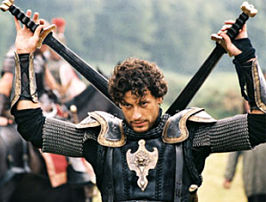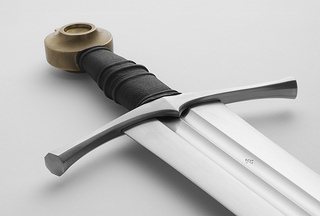A couple of weeks ago, I rented a digital copy of King Arthur (the one released in 2004). It presents Arthur as a Roman officer–a pretty radical approach which is, according to the film, supported by recently discovered archeological evidence.
Anyway, as a kid, I gobbled down any King Arthur book or movie I could find. I have pleasant, if vague, memories of the King Arthur movie starring Sean Connery as Arthur, Richard Gere as Lancelot, and Julia Ormond as Guinevere (is it just me or does she always play a woman stuck in a love triangle?), so I thought I’d give this reinterpretation a try.
I figured a movie starring Ioan Gruffudd and Clive Owen as Roman officers and Keira Knightly as a famed princess would be an enjoyable experience–and it was, but I can’t say I’ll be rushing to buy the DVD.
Anyway, after watching it, I found out it was written by David Franzoni, the same screenwriter who wrote Gladiator. It was also produced by Jerry Bruckheimer.
But King Arthur, despite its impressive pedigree, was not the critical and commercial success Gladiator was, grossing only $51 million (domestic) at the box office.
It made me wonder why was one historical epic so much more successful than the other?
Both have handsome brooding heroes. Both were big-budget pictures set during Rome’s dominance. And the most crucial similarity–both were written by the same skilled screenwriter.
I came up with a few reasons why King Arthur wasn’t as successful as Gladiator, and I think my conclusions can help strengthen your current screenplay draft, even if it isn’t a historical epic.
So here are 6 reasons why Gladiator trumps King Arthur:
An irrelevant backstory
Remember how Gladiator started?
Maximus, played by Russell Crowe, was a well-respected general in the Roman army. He won a huge victory over enemies of Rome.
His reward was to be falsely accused of murder and flee home…only to discover that his family had been murdered by Praetorian guards, on orders by Commodus, who committed patricide in order to become the new emperor of Rome. Emotionally haunting even long after you’ve seen the movie, Maximus’s personal tragedy is well suited to begin the historical epic.
King Arthur starts with a backstory that’s also tragic: we learn that the Romans fought with many different cultures in their quest to build their empire. One culture from Sarmatia had particularly skilled cavalry officers.
So skilled, in fact, that the Romans struck a bargain with them. Instead of killing the Sarmatians, the Romans would let them live, as long as the Sarmatians joined the Roman army. A little while later, we learn that the Sarmatian cavalry agreed, but they did not just bind themselves to Rome…
…they bound all of their male descendants, too.
Then we see Roman soldiers coming to a remote village in order to claim a young Sarmatian boy for the Roman army.
While not as tragic as Maximus’s experiences, it’s a solid backstory that creates instant sympathy for the little boy who had his childhood stolen from him–and automatic interest in how he handles that challenge.
But that little boy, it wasn’t Arthur.
Nope, we didn’t spend the first ten minutes of the movie seeing Arthur’s childhood, but Lancelot’s.
So when the film showed the boy, now grown into a man, and revealed it was Lancelot, I wondered if this King Arthur movie was going to have Lancelot as the main hero instead of Arthur.
It didn’t.
Arthur was definitely the main hero, while Lancelot was a supporting character (mostly underutilized, but more on that later).

Lancelot in KING ARTHUR (2004)
If Lancelot wasn’t the star of the show, then why start with his backstory? It doesn’t make sense.
Later, we do see a flashback to Arthur’s past, and it was more tragic than Lancelot’s. His home was attacked by Woads, i.e. native Britons. To defend it, he pulled the sword that marked his father’s grave from the ground…but he was too late. The Woads had already killed his mother.
That’s a very powerful backstory, but it was only revealed toward the middle of the film. It would’ve been more effective to deploy it at the beginning, replacing Lancelot’s backstory. This would garner instant sympathy for Arthur. Plus, it would make it 100% clear that Arthur is the film’s protagonist.
Here’s another idea: altering the circumstances of Arthur’s mother’s death, so that the Roman army was responsible for it instead of the Woads. Then the film could explore the conflict of being forced to work for “the Firm” responsible for destroying your life.
But maybe that plot is a little too similar to Gladiator?
A mediocre villain
The villain in Gladiator, Commodus, was an overly ambitious emperor’s son, played to perfection by Joaquin Phoenix.
Boy was he creepy. Skin-crawling creepy.
His counterpart in King Arthur is not an emperor, but a Saxon overlord Cerdric, played by Stellan Skarsgard. While we see Cerdric glower, clash heads with his son, kill an innocent woman and a tribesman who dared to question his authority…he wasn’t very menacing.
Not in the way that Joaquin Phoenix was or the way Alan Rickman was as the Sheriff of Nottingham in Robin Hood: Prince of Thieves. Sometimes, the Saxon chief came across as a medieval Anna Wintour, sedated by cough meds and sporting moth ball-eaten furs (only sometimes).
That’s not to say that Skarsgard is a bad actor. He’s quite talented, right on par with Joaquin and Alan. Despite very little screen time, he created quite an impression as Bootstrap Bill in Pirates of the Caribbean 2: Dead Man’s Chest.
In King Arthur, although he did the best with what he had to work with, his villain falls short.
I think that’s because we don’t get the sense (or at least I didn’t) that he would go to obscene lengths to achieve complete control of British land. Both Joaquin’s emperor and Alan’s sheriff were half-mad with ambition, and the way they conveyed their single-minded obsession really set them apart amongst the pantheon of movie villains.
Dropped plot lines
On the day Arthur and his knights should be released from their obligation to Rome, they are tasked with one last semi-suicidal mission: to rescue a Roman family whose son, Alecto, is the Pope’s favorite godchild…and who might be Pope himself one day.
A pretty important boy and really hefty task.
Alecto has been raised by a father who has abused his power, an act made even more reprehensible because he does it in the name of Christianity.
When Alecto is rescued, Arthur exposes his father’s cruelty, and the boy faces an important crossroad. He can follow his dad’s footsteps…or follow the principles of equality and justice espoused by Arthur and Arthur’s mentor, Bishop Pelagius.
I thought it was a compelling subplot. Like the little boy in Gladiator (played by Spencer Treat Clark), the actor in King Arthur, Lorenzo De Angelis, shined on screen. In order to save the boy, Arthur and his knights face off against an oncoming Saxon army on a frozen lake. Awesome fight sequence, btw.
Arthur is victorious, and Alecto escapes, unharmed…but we never see him or hear of him again.
I invested in the little guy, and I wanted to know what happened to him.
Did he make it to Rome? Was the sacrifice of Dagonet, one of Arthur’s knights, made in vain? Would Alecto try to build a just Rome on top of the ruins of corruption?
A ten-minute wrap-up sequence wasn’t necessary, but I did want some kind of resolution to Alecto’s story. Even if it was just a brief mention of his whereabouts at Arthur’s wedding to Guinevere…
Portrayal of Christianity
This might start some controversy, but that’s okay. A healthy debate is always good. I am sick and tired of the way Hollywood movies portray Christianity.
Sure, over the centuries, various religious leaders have abused the Christian faith to push their own agenda, line their own pockets, and accumulate power. But that doesn’t mean that EVERY Christian figure is corrupt, not to mention that this corruption is certainly not limited to the Christian faith.
In King Arthur, every Christian except for Arthur was a sociopath, and boy, did that rub me the wrong way.
Then, when I discovered that one of the villainous characters, Bishop Germanicus, was in real life a good guy, who historically: “extended his hospitality to all sorts of persons, washed the feet of the poor and served them with his own hands, while he himself fasted,”
…well…that didn’t exactly enhance my mood.
Why turn a nice Christian figure into an evil one, especially when your movie is supposed be based on “archeological” evidence? If you’re going to claim your presentation of a legend has historical proof, then you’ve got to be more faithful to historical events in ALL areas. Well, that’s most people’s expectation anyway.
Of course, Bishop Germanicus created conflict, which is a key component of any screenplay. How to maintain historical fidelity while also adhering to good screenwriting principles?
Here’s a suggestion: the filmmakers could’ve used their artistic license to create another religious figure who had equal power as Germanicus–but who was evil. Bishop Germanicus could try to help Arthur by opposing this person–at great personal risk to himself.
If the screenplay had been written with this embellishment, you still have conflict but you haven’t massacred the character of a historical figure.
Even better, you’ve portrayed Christian religious leaders in both positive and negative lights, which not only is reflective of real life but also won’t alienate a good chunk of your audience.
No love triangle
From Bridget Jones to Bella Swan, the love triangle is a popular story component.
The love triangle between King Arthur, Guinevere, and Lancelot is one which has endured for centuries…and yet it’s not depicted in this movie (which, as I mentioned earlier, means that Lancelot’s character is largely underutilized).
We get some hints at the triangle: Lancelot watches Guinevere bathing for ten seconds. He argues with Arthur about protecting Woad refugees, of which Guinny is one. But besides these few, extremely brief moments, there’s nothing in this King Arthur movie about one of the most famous love triangles of all time.
It’s an interesting omission, especially since the screenwriter, David Franzoni, made use of the love-triangle conceit in Gladiator. Maximus is still very much in love with his dead wife, but nevertheless, does develop feelings for the emperor’s sister, Lucilla.
I, for one, think the conflict and drama produced by Arthur and Lancelot rivaling for Guinevere’s affections would have made better use of Lancelot’s character.
It would’ve been ten times more interesting than some of the conflict we got, too. This is just my personal opinion, but I always find conflict within a group–whether it be a kingdom, government, school, or family–to be more interesting than conflict against another group.
Plus, I’m a sucker for a good love story.
Faithfulness to source material
I’m not sure how historically accurate Gladiator was. I’m in no mood for another quick trip to Wikipedia which normally produces more questions than answers.
But Gladiator could’ve had the most inaccurate depiction of Roman life, and it wouldn’t have mattered.
Why not?
Not many people know a lot about Rome.
They know it fell, that all roads lead to it…and it’s home to a really cool amphitheater. But that’s about the extent of it.
If there are glaring historical inaccuracies in Gladiator, only professors of ancient history and/or languages are going to notice.
More importantly, they might be the only ones who care.
In contrast, the King Arthur legend is known by and loved by many. Huge deviations from the legend aren’t going to sit well with a good number of people.
That’s why getting rid of the love triangle (not to mention painting Arthur as a Roman officer) was the death knell of this movie, in my humble screenwriting opinion.
In Selling Your Screenplay Requires Some Spanx, I advised screenwriters to embellish source material to create drama and conflict in their screenplay.
I’m going to have modify that recommendation a bit. When taking liberties with stories based on real people or adapted from well-known novels (and other forms of literature), you have to take into account (a) how well known the story is and (b) how beloved it is.
If you’re writing a screenplay based on a story that’s held dear by a large number of fanatics…then be extremely cautious of changing core elements of the original.
If, on the other hand, your screenplay is based on a story that’s not so well known and which most people aren’t emotionally attached to (like the tiny period of time when Commodus ruled Rome)…then let your flights of fancy take over.
Medieval Sword by Soren Niedziella





















Comments on this entry are closed.
Fantastic! Thank you.